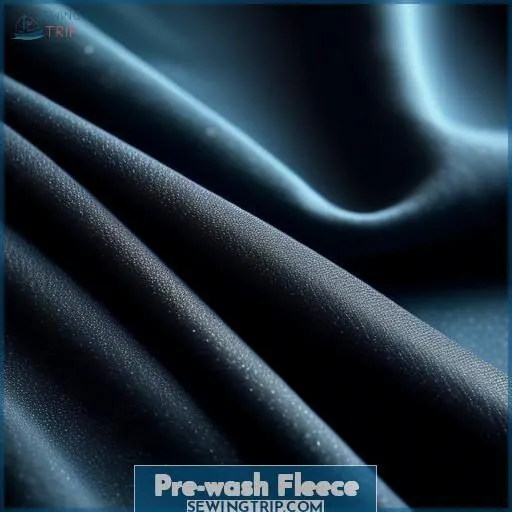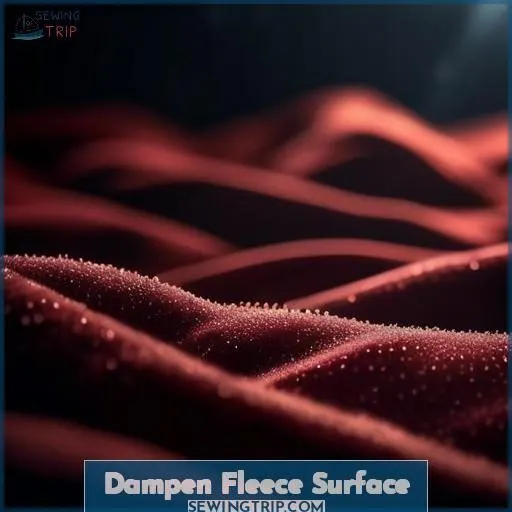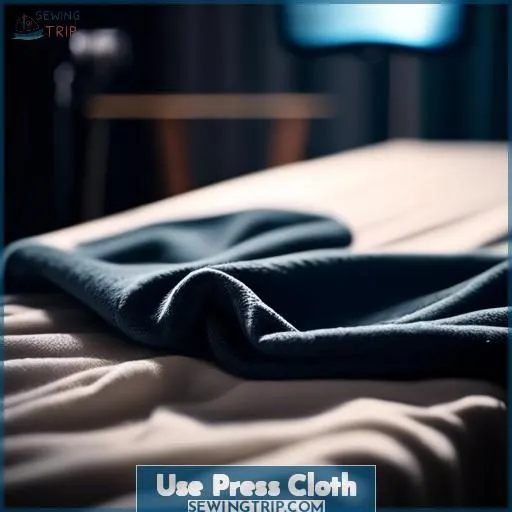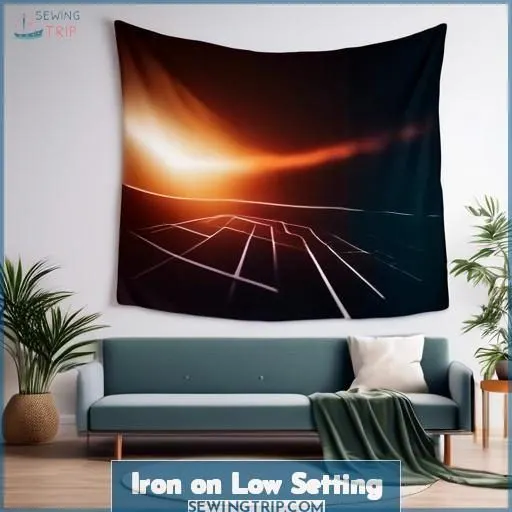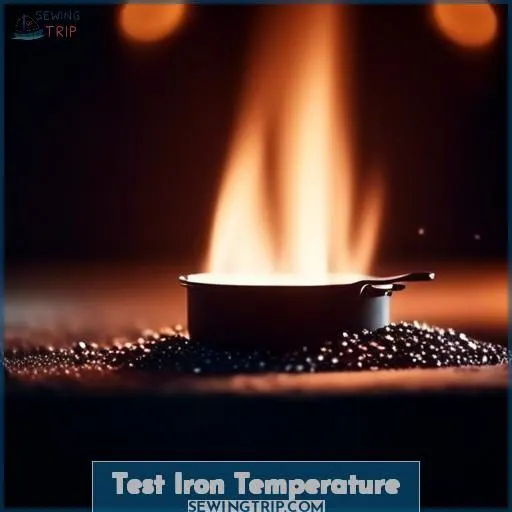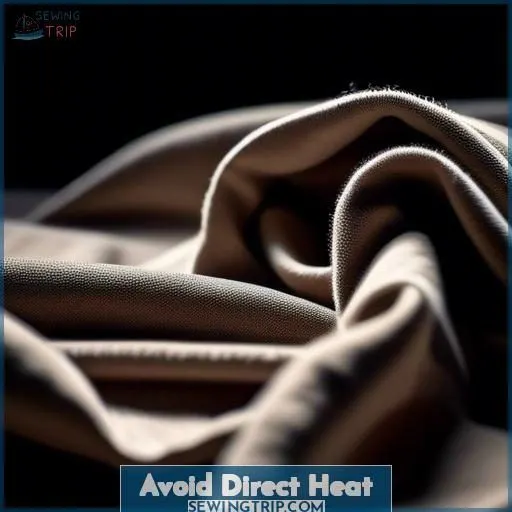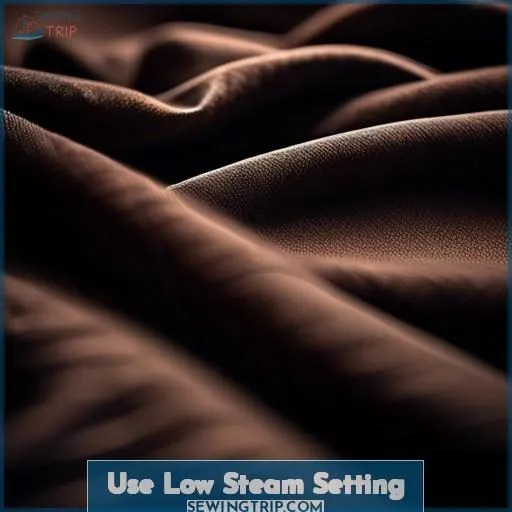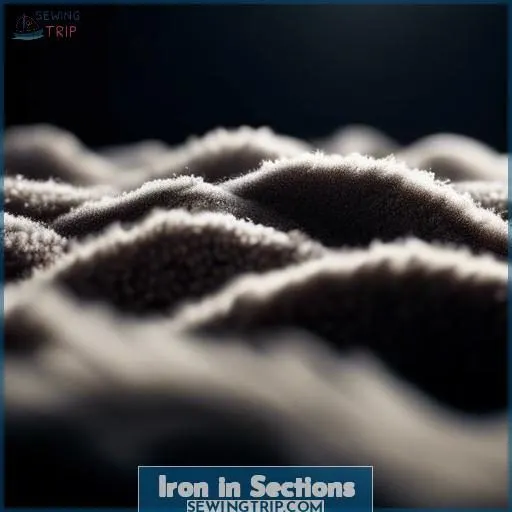This site is supported by our readers. We may earn a commission, at no cost to you, if you purchase through links.

To iron wrinkles out of fleece, dampen the fabric and use a press cloth.
Set your iron to the low or delicate setting.
Test the temperature on a scrap piece first.
Avoid direct heat by hovering the iron over the cloth.
Use short strokes and move in sections.
If needed, you can use a low steam setting with caution.
Roll or carefully fold your fleece after ironing to maintain that smooth finish.
Follow these tips for best results without damaging the cozy material.
But there’s more you can do to prep and protect fleece…
Table Of Contents
Key Takeaways
- Pre-wash fleece to remove sizing or chemicals that can cause wrinkles and shrinkage when exposed to heat and steam.
- Dampen the surface of the fleece before ironing to make it glide more smoothly under the iron and prevent damage.
- Use a press cloth to shield the fabric from direct heat and prevent burning.
- Iron on a low setting and use a low steam setting with caution to avoid overheating and damaging the fleece.
Pre-wash Fleece
To guarantee that your fleece is free from wrinkles, it’s imperative to pre-wash the fabric before ironing. Pre-washing helps remove sizing or chemicals that can cause the fabric to shrink and wrinkle when exposed to heat and steam. Here are some steps to follow:
- Wash and dry the fleece: Before ironing, make sure to wash and dry the fleece to remove any wrinkles that may be present. This step is essential for both blankets and embroidered projects.
- Use a vertical steamer with caution: If you don’t have time to wash and dry the fleece, you can use a vertical steamer to remove wrinkles. Be careful not to overheat the fabric, as this can cause shrinkage.
- Consider using Wrinkle Release spray: If you’re working with embroidered projects, you might find it helpful to use a Wrinkle Release spray to help remove wrinkles from the fabric.
- Test embroidery settings: Before starting your embroidery project, it’s a good idea to test the settings on a scrap of fleece to ensure that the embroidery process won’t cause any unwanted wrinkles or shrinkage.
- Use stabilizer: To prevent puckering during the embroidery process, consider using stabilizer to keep the fabric flat and smooth.
- Fuse with caution: When working with fusible fleece, be aware that some products may shrink when exposed to heat and steam. Test your fabric before fusing to ensure that you’re not inadvertently causing wrinkles or shrinkage.
- Pre-shrink fabric: To prevent shrinkage, you can pre-shrink your fabric by washing it before fusing. This step can help ensure that your project fits correctly and doesn’t shrink unexpectedly.
- Press project fabric well: Before beginning your project, press the fabric well to remove any wrinkles or creases. This step can help you start with a smooth, wrinkle-free surface.
- Consider increasing side seam allowances: If you’re working on a project where the fit is important, you might want to increase the side seam allowances to account for any potential shrinkage.
- Trim excess thread: After embroidering, be sure to trim any excess thread to prevent puckering or wrinkles.
Dampen Fleece Surface
To get wrinkles out of your fleece fabric, you should dampen the surface before ironing.
This can be done by using a spray bottle, atomizer, or even a damp cloth.
The idea is to make the surface slightly damp, not wet.
This will help the fabric glide more smoothly under the iron.
This step is essential to prevent any potential damage to the fleece, such as melting or discoloration.
Use Press Cloth
When pressing fleece, it’s crucial to use a press cloth to shield the fabric from direct heat and prevent burning.
A cotton washcloth is an ideal choice for this purpose.
Place the textured side of the washcloth facing the fleece.
Smooth it over the fabric to eliminate wrinkles and creases.
This protective barrier ensures that the iron’s heat is distributed evenly and doesn’t harm the fleece.
Iron on Low Setting
To achieve a smooth finish for your fleece, it’s essential to iron it on a low setting.
This will help prevent the fibers from melting and guarantee the fabric stays intact.
When ironing, use a press cloth made of a thin cotton material, such as a washcloth, to shield the fleece from direct heat.
Be sure to test the iron temperature on a scrap piece of fabric first to avoid any potential damage.
Iron in sections to prevent overheating the fabric, and be wary of the steam setting, as excessive steam can cause wrinkles.
Store your fleece appropriately to prevent wrinkles from forming, using a cool, dry place and avoiding plastic storage.
Test Iron Temperature
After adjusting your iron to a low setting, it’s essential to test the iron temperature before tackling the main event.
Grab a piece of scrap fleece as your test subject.
This step is your safeguard to prevent a mishap where your beloved fleece might melt into a pitiful, unusable mass.
Think of it as the trial run before you embark on the ironing journey.
By finding the ideal setting for fleece on your iron, you guarantee your project remains unharmed and ready for wrinkle removal.
Remove Wrinkles With Washcloth
To remove wrinkles from your fleece fabric, you can use a damp washcloth to rub the surface in different directions.
This will help coax the creases out and make the fabric smoother.
Be cautious when doing this, as the steam combined with the damp fabric can make the area very hot.
Most wrinkles will disappear with perseverance, but sharp creases at the end of a bolt may be permanent.
Avoid Direct Heat
To avoid direct heat when ironing fleece, you should use a thin cotton sheet or cloth as a protective barrier between the iron and the fleece.
This will help prevent the fleece from melting or discoloring due to excessive heat.
Additionally, it’s essential to use the lowest heat setting on your iron.
Fleece can quickly begin to shrink, discolor, or even melt when exposed to high temperatures.
Always test the temperature on a scrap piece of fleece before ironing the actual garment to prevent any damage.
Use Low Steam Setting
To iron fleece, set the iron to the cotton setting with heavy steam.
Use a cotton washcloth as a press cloth, placing the nubbiest side facing the fleece.
Be cautious of heat from steam and damp fabric.
Use a low steam setting to avoid direct contact with the fleece.
Test the temperature on a scrap first to prevent melting.
Most wrinkles will disappear with perseverance.
Store fleece properly to prevent wrinkles from forming in the first place.
Iron in Sections
To remove wrinkles from your fleece fabric, it’s crucial to iron in sections. This approach allows you to apply heat and steam more effectively, ensuring that the fabric is evenly smoothed out. Here are four steps to follow:
- Press cloth placement: Cover the fleece with a thin, breathable fabric like a cotton washcloth. This protects the fleece from direct heat and helps distribute the steam more evenly.
- Nubbiest side orientation: Place the nubbiest side of the washcloth facing the fleece. This side will absorb the steam and help relax the fibers, making it easier to remove wrinkles.
- Washcloth fabric choice: Choose a washcloth made from a material that can absorb moisture, such as cotton. This will help the steam penetrate the fabric more effectively.
- Ironing direction and steam distribution: Iron in a single direction, using long, smooth strokes. Apply steam evenly across the fabric, ensuring that the steam is distributed evenly. Be careful not to apply too much pressure, as this can cause the fleece to pucker or shrink.
Store Fleece Properly
To store fleece properly and avoid creases, use a clean, dry storage space.
Fold your fleece using techniques that minimize wrinkles, such as folding it like a book or using a rolling method.
If space is limited, consider hanging your fleece on a hanger or using a garment bag.
When storing fleece, avoid stacking it too high to prevent weight from crushing the fabric.
By following these tips, you can keep your fleece looking great and ready for use whenever you need it.
Frequently Asked Questions (FAQs)
Can I use a high heat setting when ironing fleece?
You shouldn’t use high heat on fleece – it can melt or scorch the fabric. Instead, use a low or medium setting, and always place a pressing cloth between the iron and fleece to avoid damaging it. A little patience and a cool iron will get those wrinkles out smoothly.
Is it necessary to use a press cloth when ironing fleece?
Yes, you’ll want to use a press cloth when ironing fleece. The cloth protects the delicate fabric from direct heat, preventing melting or scorching. It also helps smooth out those pesky wrinkles without damaging the cozy nap.
Can I dry fleece in a dryer on high heat?
You’re playing with fire there! Fleece melts when exposed to high heat. Dry it on a lower setting or line-dry to keep that cozy texture intact. A little wrinkle never hurt anyone, but burnt fabric? No thanks!
How do I remove wrinkles from fleece without ironing?
Toss the fleece into the dryer with a few clean tennis balls or dryer balls. The tumbling action will relax and fluff the fibers, releasing most wrinkles like magic!
Can I wash fleece in hot water?
Imagine fleece as a delicate fabric – washing it in hot water can cause excessive shrinkage and damage. For best results, stick to cold or lukewarm cycles when laundering your cozy fleece items. Gentle care helps keep them soft and wrinkle-free.
Conclusion
Coincidentally, properly ironing wrinkles out of fleece requires caution to preserve its comfortable texture.
Follow these steps:
Pre-wash.
Moisten.
Utilize a press cloth.
Iron on minimal heat after testing.
Avert direct contact.
Use swift strokes in segments.
Consider modest steam.
Proper storage post-ironing guarantees your fleece retains its smooth texture.
With patience and the correct technique, you’ll successfully iron fleece without impairing the material.

